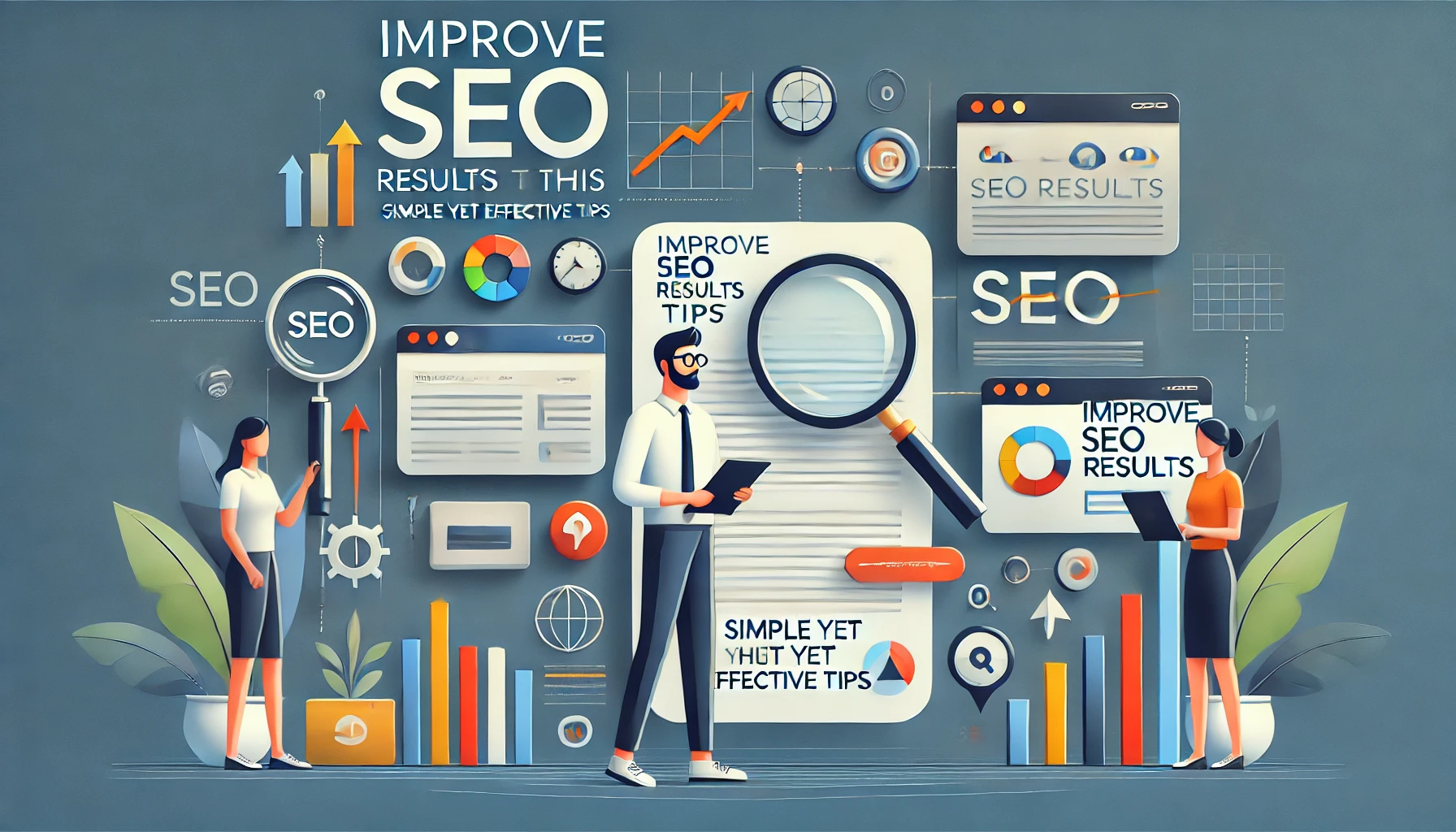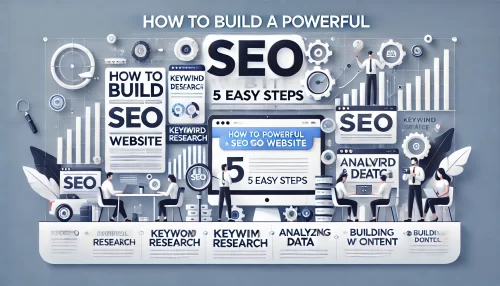Table of Contents
Are you struggling to improve SEO for your website? Wondering what simple yet effective strategies can boost your rankings?
This guide will walk you through actionable tips that will help you see noticeable improvements in your site’s SEO performance. From optimizing on-page elements to mastering content marketing, you’ll learn how to take your SEO results to the next level.
Focus on Optimizing On-Page SEO for Better Ranking
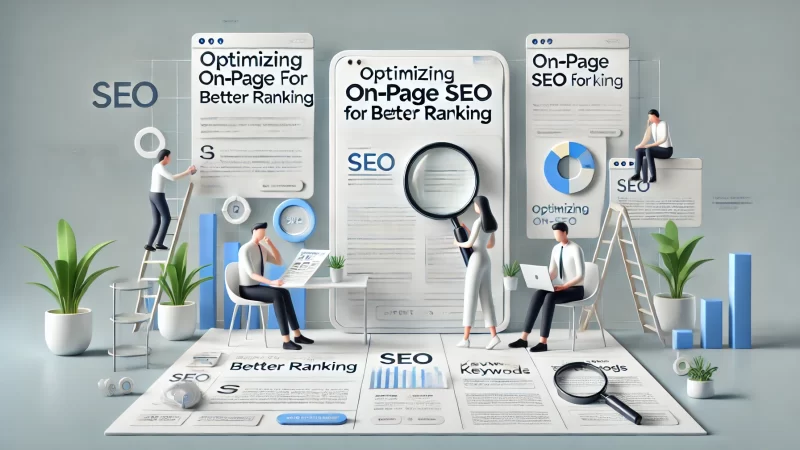
On-page SEO is the foundation of any successful search engine strategy. If you’re looking to improve SEO, focusing on these elements will help your site perform better on Google and other search engines. Let’s dive into some key strategies.
Ensure Your Title Tags Are Relevant and Keyword-Rich
Your title tags are one of the first things search engines notice. I recommend ensuring they are descriptive, relevant, and include your main keyword. This gives both users and search engines a clear idea of what the page is about.
Each title tag should be unique to avoid confusion and help search engines understand the page’s context. Keep the length within 50-60 characters, as longer tags may get cut off. It’s important to naturally integrate your focus keyword into the title tag without making it sound forced. This simple adjustment can dramatically improve SEO results.
I suggest checking competitors‘ title tags for inspiration while ensuring your title stands out. Incorporate powerful words that encourage clicks, like “best,” “essential,” or “effective,” to make your titles more compelling to users.
Updating older content with better-optimized title tags can also breathe new life into your pages. I advise regularly auditing and refining titles to maintain relevancy.
Craft Meta Descriptions That Boost Click-Through Rates
Meta descriptions, though not directly a ranking factor, can significantly impact your click-through rates. Write these descriptions in a way that grabs attention, using a conversational tone to engage users. Focus on the main benefit the reader will gain by visiting your page.
Your meta description should be concise yet compelling, with 150-160 characters being the ideal length. Including your focus keyword in a natural way will not only make the description more relevant but also more likely to match user search queries. The goal is to encourage users to click on your result over competitors.
I recommend framing the meta description as a solution to a common problem your audience faces. For example, in my case in these post, a meta description like: “Discover how to improve SEO and boost your site’s ranking with easy-to-apply techniques” matches best. This piques curiosity and provides a clear benefit.
Avoid stuffing keywords or using generic language. Users should feel like they’ll find unique, valuable information by clicking on your link.
Improve SEO by Writing High-Quality, Long-Form Content
Long-form content naturally ranks better because it provides more depth, answers more questions, and keeps users on your page longer. I suggest aiming for articles that are at least 1,500 words when covering in-depth topics. This helps improve SEO and provides comprehensive value to your readers.
The content should always focus on quality, not just length. Answering common user queries and providing actionable insights will keep readers engaged and increase the likelihood of shares or backlinks. Consider breaking up long-form content with headers, lists, and images to make it more digestible.
Search engines also prioritize freshness. I recommend updating your long-form content regularly to ensure it remains relevant and accurate. Adding new information or insights can give your SEO a boost while keeping the content valuable for returning visitors.
Don’t forget to optimize for readability. Keeping sentences and paragraphs short, while integrating visuals or examples, can make your long-form content more engaging.
Use Alt Text Effectively for Image Optimization
Alt text for images serves both accessibility and SEO purposes. It’s the descriptive text for images that search engines read, so I suggest being specific about what the image represents. This improves SEO by helping search engines understand your page’s visual content.
Your alt text should be concise but descriptive enough to convey the purpose of the image. Including your focus keyword can improve SEO, but only if it fits naturally. For example, “infographic explaining how to improve SEO rankings.” This balances relevance with keyword optimization.
Images with proper alt text can also appear in image search results, driving more traffic to your site. I recommend using this tactic for infographics, charts, and other informative visuals that users might be searching for.
I also advise against keyword stuffing in alt text. Instead, focus on clarity and relevance. Over-optimization can lead to penalties rather than improving SEO.
Structure Headings Correctly for Improved Readability and SEO
Headings help structure your content, making it easier for users to navigate and for search engines to understand. I suggest using H1 for the main title, H2 for key sections, and H3 or lower for sub-sections. This hierarchy improves SEO by emphasizing what’s most important on the page.
Each heading should include keywords where relevant but focus more on readability and flow. I recommend writing headings that are clear and descriptive, summarizing the content of each section. This helps users quickly find the information they’re looking for.
Avoid overusing the same heading structure. Diversifying your headings adds variety to the page, making it more engaging. For instance, a mix of questions and statements can make the content feel more dynamic and personal.
I suggest reviewing your headings after the first draft to ensure they accurately reflect the section’s content. Effective use of headings can significantly improve SEO and the user experience.
Leverage Internal Linking To Distribute Authority Across Pages

Internal linking is a powerful way to improve SEO by distributing authority and helping users find more relevant content. It’s also an excellent strategy for increasing engagement and keeping visitors on your site longer.
Use Descriptive Anchor Texts for SEO Benefits
Anchor text plays a key role in internal linking. I suggest using descriptive text that clearly tells readers what they’ll find when they click. Avoid generic phrases like “click here” and instead use something more specific, such as “learn how to improve SEO rankings.”
This technique makes it easier for search engines to understand the content of the linked page. It also encourages users to click through to the other content, increasing engagement and reducing bounce rates.
I recommend incorporating internal links naturally within the content. The link should provide value and flow with the rest of the paragraph. This helps improve SEO without disrupting the reading experience.
Monitor your internal links regularly to ensure they are still relevant and functional. I advise updating broken links promptly to maintain a seamless user experience and protect your SEO efforts.
Link High-Traffic Pages to Low-Traffic Pages for Balance
If you have certain pages that receive a lot of traffic, linking them to less popular pages can help distribute authority and drive more traffic across your site. This improves SEO for those low-traffic pages while maintaining the flow of authority.
I recommend identifying your high-traffic pages through Google Analytics or similar tools. From there, look for related pages that could benefit from additional visibility. Adding internal links between these pages can improve the overall user experience.
Internal links should feel relevant to both the page they’re on and the page they’re linking to. I suggest reviewing the context carefully to ensure it makes sense for users to follow the link.
In addition to improving SEO, this strategy helps keep users on your site longer, increasing engagement metrics like session duration.
Avoid Over-Optimization of Links to Improve SEO Naturally
While internal linking is important, overdoing it can have a negative impact on your SEO. I advise keeping your links strategic and meaningful, rather than linking excessively throughout the page. Too many links can overwhelm readers and dilute the value of each link.
It’s best to focus on quality over quantity. I suggest linking only when it provides real value to the user and enhances the context of your content. This will also help avoid any penalties from search engines for over-optimization.
Regularly review your internal links to ensure they’re still relevant and helpful. As your content evolves, some links may become outdated or unnecessary. Keeping them updated will maintain a high-quality user experience.
In the end, I believe that natural, purposeful linking is always better for long-term SEO success.
Strategically Place Links Where They Add Value to Users
Strategically placed links can guide users to the most relevant content on your site. I suggest embedding links in high-traffic areas of the page, such as near key information or calls to action. This encourages users to click and explore more.
Make sure the link placement feels organic within the content. For example, placing a link within an actionable tip or a detailed explanation makes it more likely that users will follow it. This method also helps improve SEO by spreading authority to important pages.
I recommend experimenting with different link placements to see what works best for your audience. Tracking user behavior can give you insights into where users are most likely to click and how to optimize future link strategies.
Be mindful of user intent when placing links. The goal is to provide users with the next logical step in their journey, which in turn helps improve SEO and engagement metrics.
Maximize Mobile Optimization for Better Search Rankings

Mobile optimization is essential for improving search rankings, as more users are browsing on mobile devices. I suggest prioritizing a mobile-friendly approach that enhances user experience, which directly impacts your SEO performance and keeps visitors engaged.
Ensure Fast Loading Times to Retain Visitors
A slow website can frustrate visitors, causing them to leave quickly. I recommend reducing page load times by compressing images and minimizing HTTP requests. This improves user satisfaction and boosts SEO by keeping visitors on your site longer.
Hosting matters too. I suggest opting for reliable, high-performance hosting that ensures your site loads quickly, especially on mobile. Mobile users are less patient with slow websites, so a fast-loading site can lead to better rankings and fewer bounce rates.
I also advise using a content delivery network (CDN) to distribute content efficiently. This helps ensure that users in different geographic locations experience faster load times, further improving your SEO.
Keep an eye on your site’s speed regularly. Tools like Google PageSpeed Insights can give valuable feedback on how to enhance performance, which can make a noticeable difference in your mobile SEO.
Optimize Images for Better Mobile Experience and SEO
Images play a significant role in page speed and mobile user experience. I recommend resizing images for mobile devices and using the proper file format, such as JPEG for photos and PNG for graphics. This not only improves load times but also enhances your mobile SEO.
Ensure every image has an appropriate alt text. This helps search engines understand the content of the images and improves accessibility. Including descriptive alt text with relevant keywords can help with SEO without keyword stuffing.
You can also consider lazy loading, which delays the loading of images below the fold until a user scrolls to them. I believe this tactic is especially helpful on mobile devices, where load speed is critical to user retention and SEO.
Lastly, compress your images without compromising quality. I suggest using tools like TinyPNG or ImageOptim to reduce file sizes. This keeps your site fast and visually appealing, which is essential for mobile optimization.
Use Responsive Design for Improved User Experience
Responsive design ensures that your website adapts to various screen sizes. I recommend using flexible layouts, grids, and images that adjust automatically to fit any device. This approach enhances the user experience and improves SEO rankings by meeting mobile-friendly requirements.
Google prioritizes mobile-first indexing, so having a responsive design can significantly impact how your site ranks. I suggest regularly testing your site’s responsiveness to ensure it looks and functions well on mobile, tablet, and desktop screens.
An easy-to-navigate mobile site keeps visitors engaged longer. I advise simplifying your navigation menu and making buttons and links easy to click. This creates a seamless experience for users, which can result in better SEO performance.
Responsive design also contributes to a consistent brand experience across devices. I believe that when users have a positive interaction on mobile, they’re more likely to return and engage further with your content, ultimately improving your SEO.
Test Mobile Usability to Find Potential SEO Issues
Testing mobile usability is crucial for identifying and fixing any SEO-related issues. I suggest using Mobile-Friendly Test tool to check if your site meets mobile optimization standards. This will help you pinpoint and resolve any barriers to a smooth mobile experience.
Common issues include small text, touch elements too close together, and unplayable content. I recommend addressing these problems to ensure that users can easily navigate your site on their mobile devices. A better user experience leads to improved SEO performance.
Regularly reviewing your site’s analytics is essential. You can track how mobile users interact with your site and where they drop off. I suggest using this data to make improvements that enhance the mobile experience and, consequently, your SEO rankings.
Make usability testing a routine part of your site maintenance. I advise conducting tests after significant updates or changes to ensure that your mobile performance remains strong. This proactive approach can help maintain or improve your SEO over time.
Strengthen Your SEO with an Effective Content Strategy
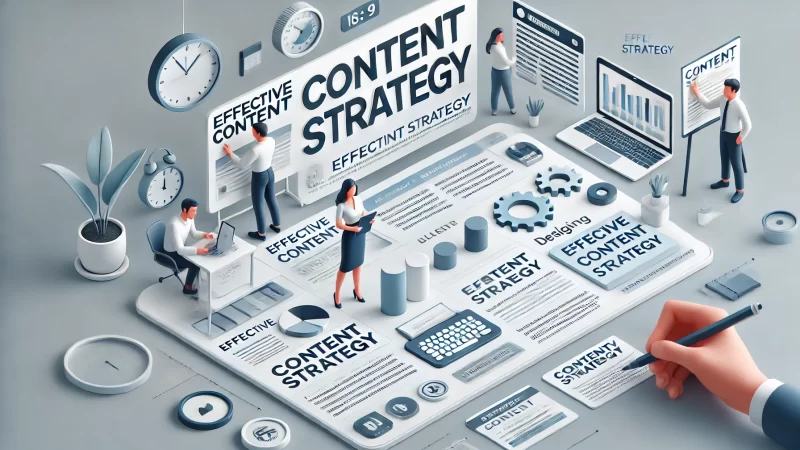
A strong content strategy is key to achieving long-term SEO success. I believe creating valuable, optimized content regularly will keep your audience engaged and improve your search engine rankings over time.
Prioritize Keyword Research to Guide Your Content Topics
Keyword research forms the backbone of any successful content strategy. I suggest starting by identifying relevant keywords that align with your audience’s search intent. Tools like Google Keyword Planner can help you discover terms with high search volume and low competition.
I recommend focusing on long-tail keywords, which are more specific and often less competitive. These can attract a more targeted audience, improving your SEO performance. For example, instead of “SEO tips,” a more targeted phrase like “simple SEO tips for small businesses” may bring better results.
Once you’ve identified your primary and secondary keywords, I suggest creating a content plan that incorporates them naturally into blog posts, articles, and landing pages. This ensures your content remains relevant and valuable to your audience.
Continuously update your keyword strategy based on search trends. I advise revisiting your keyword research periodically to stay ahead of the competition and ensure your content continues to perform well in search results.
Write Evergreen Content That Continuously Brings in Traffic
Evergreen content stays relevant and valuable over time. I recommend writing articles that answer common questions or solve persistent problems in your niche. This type of content can improve SEO by consistently driving organic traffic long after it’s published.
I advise focusing on topics that won’t become outdated quickly. How-to guides, resource lists, and in-depth tutorials are excellent examples of evergreen content. These posts can continually bring in new visitors and maintain high rankings for months or even years.
Updating evergreen content is key to maintaining its SEO value. I suggest revisiting your top-performing pieces periodically to ensure they’re up-to-date with the latest information. Refreshing these posts can keep them relevant and improve their SEO performance.
Think about the long-term when creating content. I believe investing time in evergreen articles pays off by providing consistent traffic and engagement, ultimately boosting your site’s SEO.
Incorporate LSI Keywords for Better SEO Performance
LSI (Latent Semantic Indexing) keywords are related terms that help search engines understand the context of your content. I suggest incorporating LSI keywords naturally to enhance your SEO without overloading your content with the primary keyword.
These keywords provide more depth and relevance to your content, helping it rank for a broader range of search queries. I recommend tools like LSIGraph to find related terms and phrases that fit naturally into your writing.
Using LSI keywords allows you to cover a topic more comprehensively. For example, when writing about “SEO tips,” you might also include terms like “on-page SEO” or “SEO best practices.” This helps search engines see the full scope of your content.
I advise reviewing competitor pages to see which related terms they’re using. This can give you a better understanding of the LSI keywords relevant to your topic, helping you optimize your content for better SEO results.
Use a Mix of Short and Long-Form Content for Diversity
Balancing short and long-form content helps you engage a wider audience. I suggest creating a mix of quick, informative posts and more detailed articles to keep your readers interested. This variety can also improve your SEO by catering to different user intents.
Short-form content is great for addressing specific questions or providing quick insights. I recommend using these posts to cover trending topics or to offer brief tips. These are easy to consume and can generate high engagement in a short amount of time.
On the other hand, long-form content provides more value by diving deep into a subject. I advise using this format for comprehensive guides or in-depth tutorials that offer substantial information. These pieces tend to rank higher in search results due to their thorough nature.
Both types of content serve different purposes. I believe that mixing them in your content strategy can attract more visitors and boost your site’s overall SEO, as it satisfies both quick-browsing users and those looking for in-depth information.
Use Backlinking Techniques To Improve Domain Authority
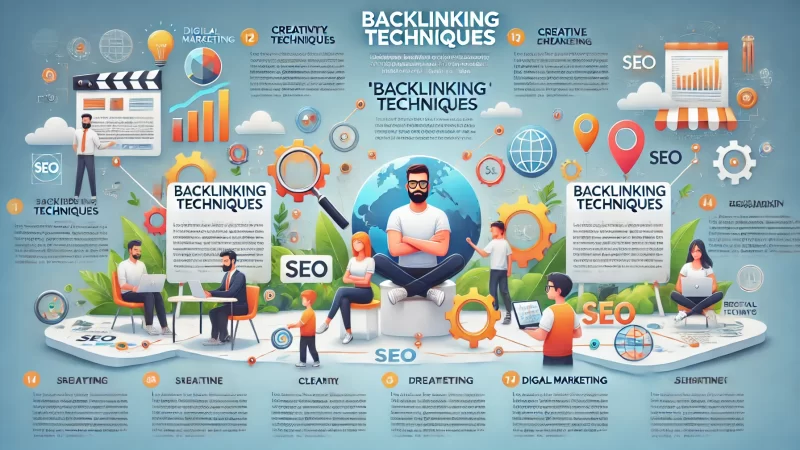
Backlinks are a key factor in improving domain authority and SEO. I suggest focusing on earning high-quality backlinks from reputable sources to boost your website’s credibility, which helps search engines view your site as more authoritative.
Earn High-Quality Backlinks from Authoritative Websites
Securing backlinks from authoritative sites can significantly impact your rankings. I recommend reaching out to established websites in your niche, as getting mentioned by them signals to search engines that your content is trustworthy. It helps build credibility and improve SEO.
Guest blogging is a popular way to earn quality backlinks. By offering valuable content to authoritative blogs, you can link back to your site in exchange. I believe this strategy not only improves your domain authority but also increases your visibility.
Creating high-value resources, like in-depth guides or research, also attracts backlinks. When your content provides useful insights, others naturally reference it. This, in turn, boosts your SEO and drives more organic traffic to your site.
Lastly, I suggest leveraging broken link building. Find relevant content on authoritative sites with broken links and offer your content as a replacement. It’s a win-win: you gain a backlink, and they fix an issue on their page.
Conduct Outreach Campaigns to Boost Backlink Opportunities
Outreach campaigns are vital for building relationships and earning backlinks. I advise personalizing your outreach to each recipient, as generic emails are often ignored. When you show genuine interest in their work, you’re more likely to get a positive response.
Timing matters. I recommend reaching out when you have fresh content or insights that are highly relevant to their audience. This increases the chances of them linking to your content because it offers immediate value to their readers.
You can also collaborate with influencers or bloggers in your industry. I suggest offering something in return, such as cross-promotion, to increase your chances of securing a backlink. Building strong relationships with influencers can lead to ongoing backlink opportunities.
Persistence is key. Don’t get discouraged if you don’t receive responses right away. I believe following up politely can remind recipients of your request and often results in higher response rates, helping you build more backlinks over time.
Create Link-Worthy Content to Attract Natural Backlinks
Content that earns natural backlinks is often unique, insightful, or solves a specific problem. I recommend focusing on creating in-depth articles, data-driven reports, or interactive content that others will want to link to for reference purposes.
Visual content, like infographics, is highly shareable and often attracts links. I suggest creating visually appealing assets that summarize complex data or processes, as they tend to be more engaging and easier for others to reference in their own content.
Keeping your content up-to-date also plays a role in attracting backlinks. I advise regularly updating your posts to include the latest information, which increases the chances of others linking to it. Fresh, accurate content is always more link-worthy.
Consider creating comprehensive guides or cornerstone content on specific topics. I believe these extensive resources serve as valuable references for other websites, making them more likely to link back to your content as a trusted source.
Monitor and Disavow Toxic Backlinks That Harm SEO
Not all backlinks are beneficial. Toxic backlinks from spammy or irrelevant websites can harm your SEO. I suggest regularly monitoring your backlink profile using tools like Ahrefs or SEMrush to spot any harmful links that could negatively affect your rankings.
If you find toxic backlinks, it’s important to disavow them to protect your site’s reputation. I advise using Google’s Disavow Tool to tell search engines to ignore these harmful links, which helps prevent them from dragging down your SEO performance.
Building relationships with high-quality sites should always be your focus. I believe that by maintaining a clean backlink profile, you’ll ensure your domain authority grows in the right direction without interference from negative sources.
Stay proactive in backlink management. I recommend setting regular intervals to audit your backlinks. This allows you to quickly address any potentially harmful links and maintain a strong SEO strategy.
Improve SEO With Regular Website Audits and Monitoring
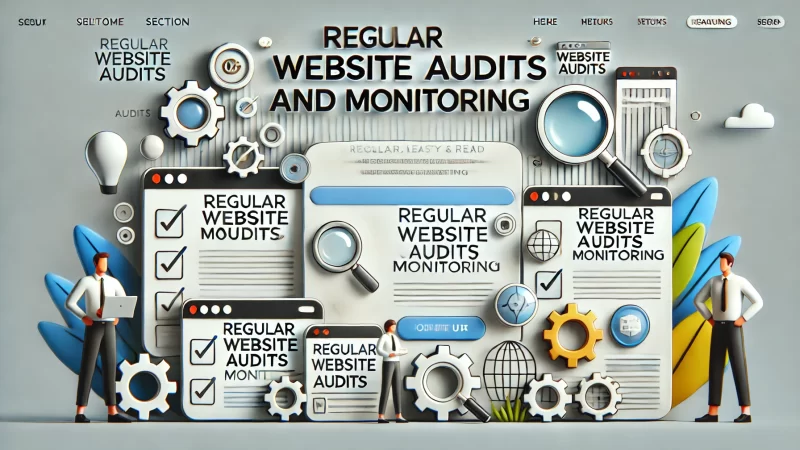
Conducting regular website audits is essential to identifying SEO issues and maintaining optimal performance. I suggest making audits a routine practice to catch any problems early and improve your site’s visibility in search engines.
Track Key Metrics Like Bounce Rate and Dwell Time
Bounce rate and dwell time provide insights into how users engage with your site. I recommend tracking these metrics to understand if visitors find your content helpful. High bounce rates suggest users leave quickly, which can negatively affect your SEO.
Dwell time is an indicator of user satisfaction. I advise creating engaging, relevant content that keeps users on the page longer. When visitors spend more time on your site, it signals to search engines that your content is valuable, improving your rankings.
I suggest improving page load times and offering clear, easily navigable content to reduce bounce rates. Fast, well-organized pages encourage visitors to stay and explore, increasing dwell time and overall user engagement, both critical for SEO.
Tracking these metrics consistently helps you make informed decisions. I believe regular analysis of bounce rate and dwell time will guide you in refining your content and optimizing user experience, improving your SEO performance over time.
Analyze SEO Performance Using Google Search Console
Google Search Console is a powerful tool for monitoring SEO performance. I suggest regularly checking it to track your site’s visibility, indexing issues, and search traffic. This helps you identify areas where improvements can be made to enhance your rankings.
I recommend paying close attention to the “Performance” tab. Here, you can see which keywords drive the most traffic to your site. Use this data to optimize underperforming pages by incorporating relevant keywords that match user intent.
I advise checking the “Coverage” report for any indexing errors. Fixing these issues ensures that all your important content is properly indexed by search engines, which improves SEO and increases the likelihood of your pages being ranked.
Set up alerts within Search Console to notify you of any significant changes. I believe staying on top of these updates allows you to quickly address potential issues before they affect your search visibility.
Identify and Fix Technical SEO Issues That Impact Ranking
Technical SEO issues, like broken links or missing metadata, can hurt your rankings. I recommend running regular audits using tools like Screaming Frog to identify any technical errors that may be affecting your site’s SEO performance.
I suggest focusing on fixing 404 errors, as these lead to a poor user experience and can lower your rankings. Ensuring all internal and external links are functional is crucial for maintaining a healthy site and improving your SEO.
Optimize your XML sitemap and robots.txt file. These help search engines crawl and index your site effectively. I believe optimizing these technical elements ensures search engines have no trouble understanding and ranking your pages.
Website speed and mobile-friendliness also fall under technical SEO. I advise addressing any speed or mobile issues identified in your audits. A fast, mobile-optimized site is essential for improving both user experience and search rankings.
Regularly Update Old Content To Maintain SEO Value
Keeping your content fresh and up-to-date is essential for maintaining SEO value. I recommend reviewing older posts to ensure they still offer relevant, accurate information that aligns with current trends and search queries.
Updating old content with new data, insights, or keywords can help improve its search rankings. I advise incorporating current keywords that reflect how users are searching today, which can breathe new life into old posts and improve their performance.
I suggest refreshing content formatting as well. Adding new headers, images, or interactive elements can make older posts more engaging, increasing the time users spend on the page. This helps improve dwell time and signals content relevancy to search engines.
Regularly updating older content is an easy way to maintain its SEO effectiveness. I believe this practice not only helps with rankings but also keeps your audience engaged, ensuring they return for the most accurate and valuable information.
Improve User Engagement Metrics for SEO Success
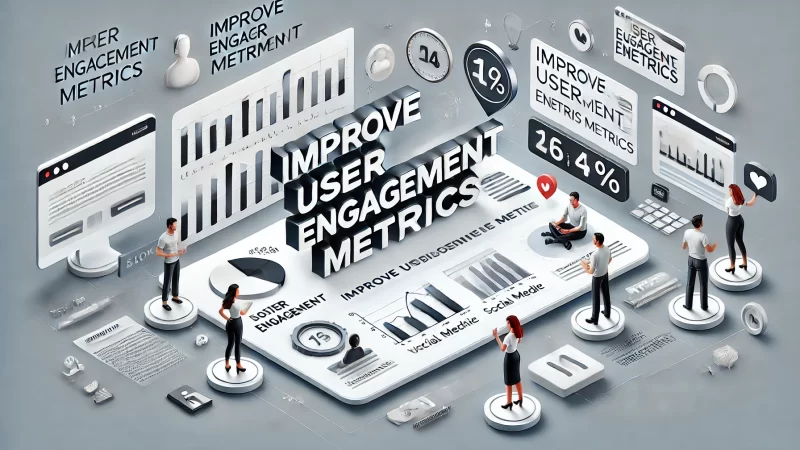
User engagement metrics like bounce rate, time on page, and interactions directly impact your SEO performance. I suggest optimizing your website’s user experience to keep visitors engaged, as this signals to search engines that your content is valuable and relevant.
Reduce Bounce Rate by Optimizing Page Load Speed
Page load speed is crucial for keeping visitors on your site. I recommend improving load times by compressing images and using browser caching. Faster sites provide a better experience, reducing bounce rates and improving SEO performance.
Choose lightweight themes and plugins to enhance speed. Overloaded websites slow down users, increasing their likelihood of leaving. I suggest trimming unnecessary elements, which also improves navigation and encourages visitors to explore further.
I advise using tools like Google PageSpeed Insights to monitor and improve your site’s performance. Regular audits help identify areas that may be dragging down load times, which, once addressed, can lead to better user engagement and SEO success.
Consider lazy loading for images and videos to boost performance. This method only loads content when the user scrolls, which helps reduce load times and keeps users engaged, lowering the bounce rate and positively impacting SEO.
Use Interactive Elements to Keep Visitors on the Page
Interactive features like quizzes, polls, and videos can captivate your audience. I suggest incorporating these elements strategically to enhance engagement. The more time visitors spend interacting with your site, the better your SEO metrics will perform.
I recommend integrating simple tools like comment sections or clickable infographics. These elements invite users to participate, making them feel involved and increasing the likelihood of them staying longer on your page, boosting your SEO in the process.
Interactive content can also drive more social shares. Embedding shareable infographics or offering tools that require input, such as calculators, helps create an engaging experience. I believe this keeps visitors on the page and improves overall engagement.
Don’t overload the page with too many features. I suggest a balanced approach, integrating one or two interactive elements that complement your content. This keeps the experience smooth and enjoyable, increasing visitor retention and benefiting your SEO.
Improve SEO by Crafting Engaging and Readable Content
Crafting engaging content is essential for SEO. I suggest writing in a conversational, relatable tone that speaks directly to your audience. When users find your content enjoyable and easy to read, they’re more likely to stay longer and return, improving SEO.
Use short paragraphs and simple language. I believe breaking up the text into digestible sections, with clear headers and bullet points, keeps users on the page longer, enhancing both readability and engagement metrics, which boosts SEO performance.
I recommend telling stories or offering examples to make the content relatable. Personal touches can make a big difference in connecting with your readers, keeping them engaged with your content and signaling its value to search engines.
Incorporating visuals such as images or infographics helps make content more engaging. I advise using these elements strategically to break up text, add value, and keep visitors interested. Visually appealing content increases dwell time and positively impacts SEO.
Encourage Social Sharing to Increase Traffic and Engagement
Social sharing drives more traffic to your site, boosting engagement and visibility. I recommend making it easy for users to share your content by including social media buttons on key parts of your page. More shares often lead to higher SEO rankings.
Create shareable content, like listicles or how-to guides, that people find valuable. I suggest framing your content around practical advice that’s easy to share. When people share, it drives new visitors to your site, improving traffic and engagement.
I also suggest engaging with your audience on social media. Responding to comments or mentions shows that you value your readers, which can encourage more interaction. Building these connections can lead to more shares and a higher SEO ranking.
Another approach is running promotions or offering incentives. For example, I advise offering free resources in exchange for social shares. This encourages users to spread the word, increasing traffic to your site and improving your overall SEO.
Harness Local SEO Strategies for Targeted Traffic
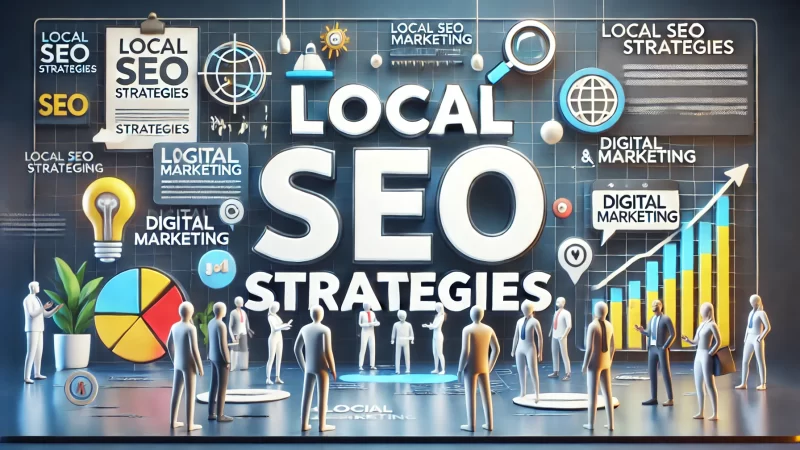
Local SEO helps businesses connect with nearby customers who are actively searching for their services. I suggest focusing on local strategies like optimizing your Google My Business profile and using locally relevant keywords to drive targeted traffic to your site.
Optimize Google My Business Profile for Local Visibility
Your Google My Business (GMB) profile is a crucial element of local SEO. I recommend ensuring your profile is fully optimized with accurate, up-to-date information. This helps your business appear in local search results and boosts your overall visibility.
Add high-quality photos of your business to your GMB listing. I suggest including images that showcase your products or services, as this can attract potential customers. A well-maintained profile with visuals creates trust and increases engagement.
I advise keeping your business hours and contact details updated. Consistency across all platforms, including your website and GMB, is essential. This reduces confusion and enhances trust, improving local SEO rankings.
Encourage customers to leave reviews on your GMB profile. Positive reviews enhance your credibility and attract more customers. I suggest politely asking satisfied customers to share their experiences, as this can significantly improve your local SEO.
Improve SEO by Building Citations and Consistent NAP Data
Citations are online mentions of your business’s name, address, and phone number (NAP). I recommend ensuring that your NAP data is consistent across all platforms. This consistency signals to search engines that your business is credible, improving local SEO.
Citations from authoritative websites, such as Yelp or local business directories, can boost your local rankings. I suggest submitting your business details to trusted directories to enhance your visibility and increase the chances of being found in local searches.
Regularly audit your NAP data to catch inconsistencies. I believe maintaining accurate information across all listings is crucial, as even small discrepancies can negatively affect your SEO. Consistency across platforms builds trust and improves search rankings.
I suggest building citations from industry-specific sites, which can further enhance your local SEO. These citations signal that your business is relevant to specific local audiences, which can drive targeted traffic and improve your overall SEO performance.
Target Local Keywords for Specific Audience Reach
Using local keywords helps attract nearby customers who are searching for services like yours. I suggest conducting keyword research to find terms that are relevant to your area, such as “best coffee shop in [city]” or “[service] near me.”
Incorporating these local keywords naturally into your content, meta descriptions, and headers will make your site more visible in local searches. I advise writing content that answers common local queries, which helps drive targeted traffic and improves SEO.
Creating location-specific pages can boost local SEO. For example, if you serve multiple areas, I suggest developing unique content for each location. This ensures search engines recognize the relevance of your services in those specific areas.
Regularly update your content with fresh local keywords based on trends or seasonal searches. I believe keeping up with what’s happening locally can help you stay relevant in search results, attracting more visitors from your target area and boosting SEO.
Encourage Customer Reviews to Boost Local SEO Rankings
Customer reviews not only build trust but also boost local SEO. I suggest asking your satisfied customers to leave reviews on platforms like Google or Yelp. Positive reviews help your business stand out and improve your visibility in local search rankings.
Responding to reviews shows that you value customer feedback. I recommend replying to both positive and negative reviews promptly. This engagement builds credibility with future customers and helps improve your overall local SEO performance.
I advise making it easy for customers to leave reviews by providing direct links in follow-up emails or on your website. When you simplify the process, more customers are likely to share their experiences, which benefits your SEO and business reputation.
Regularly monitor your review platforms. I suggest keeping an eye on what customers are saying and addressing any concerns quickly. Consistent, high-quality reviews signal to search engines that your business is reputable, improving your local SEO rankings.
Conclusion:
Incorporating these simple yet effective SEO tips can make a significant impact on your website’s ranking and performance. Whether you’re focusing on optimizing your on-page SEO, improving user engagement, or leveraging local SEO strategies, these techniques will help you improve SEO and achieve lasting success.
Frequently Asked Questions (FAQ)
How does internal linking improve SEO?
Internal linking improves SEO by helping search engines understand the structure of your site. When you link from one page to another, it distributes link equity and highlights the importance of specific content. This also encourages users to explore more pages, increasing their time on your site, which boosts SEO.
Why is mobile optimization essential for better SEO results?
Mobile optimization is crucial because search engines, like Google, prioritize mobile-first indexing. This means the mobile version of your site is considered when determining rankings. A mobile-optimized site provides a better user experience, improves load speed, and reduces bounce rates, all of which contribute to better SEO.
What are some effective backlinking techniques to improve SEO?
To improve SEO through backlinking, focus on earning links from authoritative websites. I recommend guest blogging, creating shareable content like infographics, and conducting outreach campaigns to get backlinks from reputable sources. Also, leveraging broken link building helps you replace outdated links with your content, improving your domain authority.
How can keyword research strengthen my content strategy?
Keyword research helps you understand what your audience is searching for and which terms have the most potential for driving traffic. By targeting relevant keywords, you can create content that meets user intent, improving your chances of ranking higher. Strong keyword research also helps you identify opportunities for long-tail keywords that are less competitive but highly valuable.
What metrics should I track during a website SEO audit?
During an SEO audit, track metrics like bounce rate, organic traffic, page load speed, and click-through rates. I suggest using tools like Google Analytics and Google Search Console to monitor keyword rankings, identify technical SEO issues, and assess site performance. Fixing these areas can enhance your SEO efforts.
How can user engagement metrics impact SEO performance?
User engagement metrics, like bounce rate, dwell time, and pages per session, provide insights into how users interact with your site. Search engines reward sites that engage users, as higher engagement suggests valuable content. Improving these metrics can lead to better SEO performance, as it signals to search engines that users find your content helpful and relevant.


